
Amphiglossus is a genus of skinks, lizards in the family Scincidae.

Brachymeles is a genus of skinks. The majority of the species within the genus are endemic to certain island ecosystems in the Philippines. In 2018, the Zoological Society of London through its EDGE of Existence Program listed the Cebu small worm skink as the 80th most evolutionarily distinct and globally endangered reptile species in the world, making it the most endangered member of the genus Brachymeles.
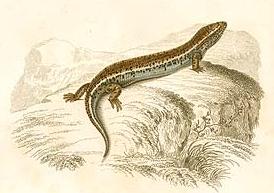
Chalcides is a genus of skinks.
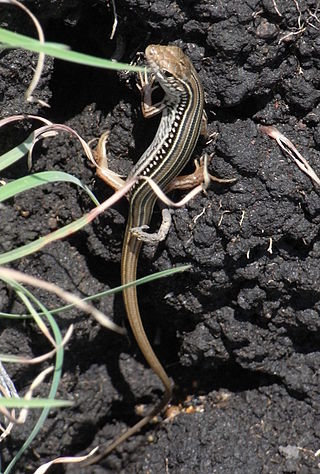
Ctenotus is a genus of skinks, lizards in the family Scincidae. The genus is endemic to Australia. The genus Ctenotus belongs to a clade in the Sphenomorphus group which contains such genera as Anomalopus and the close relatives Eulamprus and Gnypetoscincus.

Eulamprus is a genus of lizards, commonly known as water skinks, in the subfamily Sphenomorphinae of the family Scincidae. The genus is native to Australia.
Glaphyromorphus is a genus of lizards in the skink family (Scincidae).

The earless skinks form the genus Hemiergis in the skink family Scincidae. All earless skinks are native to Australia. They are also called mulch skinks.

Lampropholis is a genus of skinks, commonly known as sunskinks, in the lizard subfamily Eugongylinae of the family Scincidae. The genus Lampropholis was previously found to belong to a clade with the genera Niveoscincus, Leiolopisma and others of the Eugongylus group within Lygosominae. All species of Lampropholis are endemic to Australia. For similar skinks see genera Bassiana, Pseudemoia, and Niveoscincus.
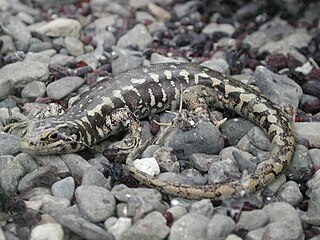
Oligosoma is a genus of small to medium-sized skinks found only in New Zealand, Norfolk Island and Lord Howe Island. Oligosoma had previously been found to belong to the Eugongylus group of genera in the subfamily Lygosominae; the Australian genus Bassiana appears to be fairly closely related.

Ophiomorus is a genus of Old World skinks. The limbs are either reduced or absent, depending on the species. They are sometimes known as limbless skinks or snake skinks. Members of the genus live under rocks or in burrows.

The genus Sphenomorphus – vernacularly also known as the common skinks – currently serves as a "wastebin taxon" for numerous skinks. While most or all species presently placed here are probably rather close relatives, the genus as presently delimited is likely to be not monophyletic and is in need of review. Some species in this genus have been moved to Pinoyscincus.
Tropidophorus is a genus of semiaquatic lizards in the skink family (Scincidae), found in Indochina, Borneo, Sulawesi, and the Philippines. They are sometimes known as water skinks or waterside skinks.
Anomalopus mackayi, commonly known as the five-clawed worm skink, long-legged worm skink, and Mackay's burrowing skink, is a species of smooth-scaled burrowing skink, a lizard in the family Scincidae. The species is endemic to eastern Australia.

Pseudemoia entrecasteauxii, also known commonly as Entrecasteaux's skink, the southern grass skink, the tussock cool-skink, and the tussock skink, is a species of lizard in the family Scincidae. The species is endemic to Australia.
Anomalopus swansoni, also known commonly as the punctate worm-skink or Swanson's burrowing skink, is a species of lizard in the family Scincidae. The species is endemic to Australia.
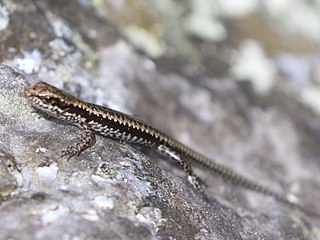
Concinnia is a genus of skinks in the subfamily Lygosominae.
Praeteropus gowi, also known commonly as Gow's burrowing skink and the speckled worm-skink, is a species of lizard in the family Scincidae. The species is endemic to Queensland in Australia.
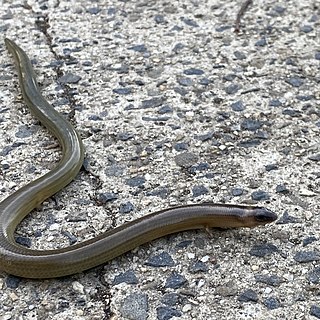
Anomalopus verreauxii, also known commonly as the three-clawed worm-skink or Verreaux's skink, is a species of lizard in the family Scincidae. The species is endemic to Australia.
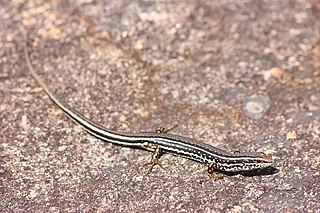
Ctenotus labillardieri, also known commonly as the common south-west ctenotus, Labillardier's ctenotus, and the red-legged ctenotus, is a species of skink, a lizard in the family Scincidae. The species is endemic to the Australian state of Western Australia.
Praeteropus is a genus of worm-skinks, smallish smooth-scaled burrowing lizards in the family Scincidae. The genus is endemic to the eastern half of Australia. The genus belongs to a clade in the Sphenomorphus group which contains such genera as Ctenotus and the close relatives Eulamprus and Gnypetoscincus.














